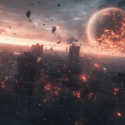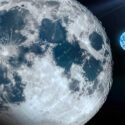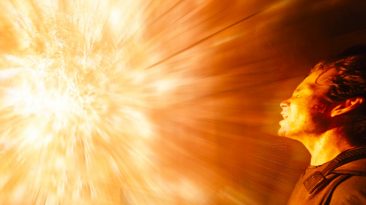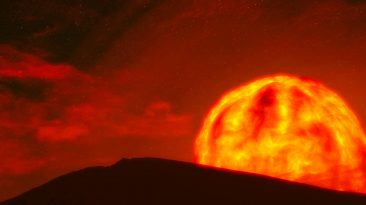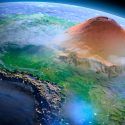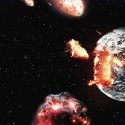This blue, marble-like planet looks just like Earth. But only five seconds on this hostile death-orb would kill you. Welcome to HD 189733b. This planet is enormous. Even larger than Jupiter. And to keep comparing it to the largest planet in our Solar System, it’s also entirely made of gas. That’s why scientists classify HD 189733b as a hot Jupiter.
This planet is located so close to its star that it completes its orbit in just over two days. HD 189733b is 13 times closer to its star than Mercury is to our Sun. Even though its star is cooler than ours, this fake Earth is still way outside of its star system’s habitable zone. This means no liquid water can exist on a planet’s surface. How this giant gaseous planet developed so close to its star is still a mystery. One theory is that HD 189733b formed right next to it during the star’s earliest moments. Or it could have developed further away, only to be pulled in as the rest of the planetary system formed. But there’s one thing we know for sure. A visit to HD 189733b would be a plunge into hell with no chance of escape.
Even if you knew there wasn’t a single drop of liquid water on this planet, you’d have a hard time believing it as you approached this giant blue marble. With an average daytime temperature of nearly 1,100 °C (2,000 °F), this planet is twice as hot as Venus. And Venus is the hottest planet in our Solar System.
One of the reasons for this intense heat is that the planet is tidally locked to its star, just like our own Moon is to Earth. That means HD 189733b takes as much time to spin on its axis as it does to revolve around the star. One side of the planet is constantly in daylight, while the other is shrouded in darkness.
The inviting look of this world doesn’t come from its oceans like it does here on Earth. No, this hellish planet gets its color from clouds of molten silicate particles. These particles scatter more blue light than red, making the planet appear blue. Silica is the primary ingredient in glass. You should bring a heavy-duty umbrella because you’d need to take cover from what would essentially be hot, molten glass rainstorms.
That’s not the only danger. You’d need to be ready to brace yourself against the extremely powerful winds that you’d find sweeping across the planet. With speeds up to 7,000 km/h (4,500 mph), these gusts are almost 30 times stronger than even the most powerful category 5 hurricanes on Earth. Compared to the strongest winds on other planets in our own Solar System, HD’s winds are almost four times stronger than those on Neptune. But hey, they might smell a little better than the ice giant’s hydrogen sulfide clouds. Those carry a whiff of rotten eggs. Ew.
HD’s winds are so fast that they’d whip past you about six times faster than the speed of sound. They would be extremely loud. But I think you’d be more worried about them tearing your body apart. Or not. You might be long gone by now, killed by that molten glass rain. In any case, you wouldn’t last too long on HD 189733b. I really don’t recommend traveling there. But there are some planets out there that can kill you even faster.
Check out OGLE-TR-56B. This gas giant sits in a galaxy nearly 100 light years away from Earth. It’s ever larger than HD. Its mass is nearly 1.4 times as much as Jupiter’s. And somehow, it’s even closer to its star too. You’d find this world to be incredibly scorching hot. Surface temperatures on this planet average around 1,700 °C (3,000 °F). That’s so hot that it turns metal to gas, creating iron clouds in the upper atmosphere. If you got caught in the rain here you’d find it to be an extremely unpleasant and deadly shower of hot molten iron. Your skin would burn right off, and so would all your insides.
But things could get even hotter. Some 670 light-years away from Earth, there’s a planet so hellish that it’s tearing molecules apart. Meet KELT-9b. This gas giant is almost three times more massive than Jupiter. It takes KELT only one and a half Earth days to speed through the orbit around its sun. And just like HD 189733b, it’s tidally locked, with one side always facing the hot star. Landing on this planet, you’d experience temperatures as high as 4,300 °C (7,800 °F). It’s the most scorching exoplanet we have ever discovered. Scientists call this gas giant an ultrahot Jupiter.
Those high temperatures also make KELT-9b hotter than most stars in the Universe. So hot that it would destroy you. C’mon. This world rips apart molecular hydrogen gas. What do you think it would do to your body? But before you even arrive on this hot planet, you’d be exposed to deadly amounts of radiation coming from its host sun. KELT-9b receives about 44,000 times more energy from its star than Earth does from the Sun. This radiation would cook you alive. Instantly.
If somehow you managed to survive all the lethal radiation of KELT’s star and the unimaginable heat of the planet, you’d still have to take on its incredibly strong winds. Scientists think those winds could reach speeds of 60 km/s (37 mi/s). That’s 30 times faster than the winds on the deceiving Earth-looking planet HD 189733b. So, KELT-9b would swirl you, burn you and tear your molecules apart. Hmmn, 1/10, would not recommend.
Sources
- “Goldilocks” Stars May Be “Just Right” for Finding Habitable Worlds. (2019). Nasa.
- On Giant Blue Alien Planet, It Rains Molten Glass. Howell, E (2019). Space.com.
- Strange ‘Hot Jupiter’ Alien Planets Come Into Focus. Wall, M (2013). Space.com
- Solar System Temperatures. Nasa (2022). Solar System Exploration.
- What Is the Speed of Sound? Howell, E (2013). Live Science.





